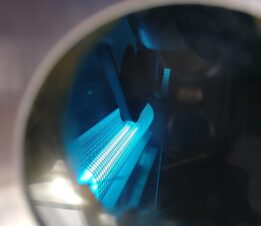Customer Rescue: Unpredictable Iron
by Dave Duren – Northstar Water
Just as sure as winter comes, winter goes and spring arrives. Oh how I wish that Iron in the water was as predictable. There is a huge wow factor in the thought of “what if” a well driller knew where the Iron was when he drilled that well for you? Oh how predictable that would be (and profitable). But guess what? We cannot predict where the Iron is and a lot of times we don’t know how heavy it will be day after day, month after month, even year after year.
I’ve come to the conclusion that one of the best places to find common ground on the subject, is that treating Iron is never fun, but most of us will encounter it sometime in our water treatment career. Now please keep in mind the target audience of this magazine is the plumbing contractor and not necessarily the water treatment dealer (I term this as the guys whose entire business is water treatment and filtration 24/7). Those guys see it A LOT more than you guys and thus have their own opinions about Iron and how to treat it. From previous articles you may recall that in general, your more likely to find water with Iron that will be troublesome from a private well supplying water to the home or building (We’ll keep it to home in this article). Although I have encountered some smaller, regional water suppliers that have not totally eliminated Iron and have complaints of iron in their water also. For instance, I do recall this in Pasco County, Florida working long ago with my good friends Eric and Colleen Suojanen from Suojanen Plumbers and a sub-division they were working in.
As a refresher on this subject, let me explain a bit about Iron. And I’m purposefully keeping this article “high level” without throwing a bunch of numbers or elemental symbols at you. Our government has set standards and levels of various contaminants that are “allowable” in the drinking water that a municipality may supply its population with. This is called the Safe Water Drinking Act (SDWA). In general there are two areas that impurities in the water fall into. They are what we call “health effects” and “aesthetics”. An example in the first area that most of us can relate to in the health effects category is Lead. Lead is not good for us. The government has set certain limits as to how much lead is permissible in drinking water. Most of us receive a statement from our municipal water supplier each year telling us what is in our water. This includes lead. The second area is aesthetics, which includes iron. The general thought here is that ingesting iron will not hurt you; it just doesn’t taste real good. So the government allows iron. Probably the most dis-liked part of iron is its staining characteristics. And it doesn’t take very much at all to cause these problems. Stop and think about it. Iron is OK, by government standards to leave in your drinking water. So what if the city of Eagan (where I live) took their water from a well that had iron in it and just got all the “bad” impurities out and left the iron. Now they are charging me for the water and I then get nasty red rings in my tub, toilet, showers, laundry sinks, etc. from iron, not to mention white clothes are ruined and turning red. I wouldn’t put up with it. So the municipalities spend the money and remove the iron, even though it is just an aesthetic problem or else their “customers” would be up in arms about it.
So that leads us back to you, our plumbing contractor. So when you come across some iron issues the homeowner is complaining about, what do you do? The first thing is do an iron test. If more than .3 ppm of iron is present, then staining can occur. The major second step is to determine what TYPE iron is there. What you really need to know is that the iron IS NOT “Bacterial Iron”. (I’m not dealing with its removal in this article). One of the fastest and best ways to check is to go to a toilet in the house, take off the tank lid and look into the tank. If you see a bunch of slimy, reddish algae-ish looking crud, then it’s bacterial iron. If you don’t see this then you can pretty much proceed and deal with the iron in a more simple fashion. You probably have “clear water” iron, called Ferrous Iron. If you have clear water iron, when you can draw a glass of water, the water will look clear. But if you let it sit awhile, you’ll start to notice red sediment appearing in the bottom of the glass. This is iron that has “oxidized”.
In general there are a couple of ways to get iron out of the water. The first way is with ion exchange. This would be a traditional water softener. Softeners are rated for a certain amount of iron so you will need to check the manufacturer’s specifications. They do a great job removing iron to certain levels. But here’s where you need to step with caution. If the iron test shows the iron to be near the top of a spec for a certain water softener, then additional equipment solely to treat the iron may be needed. This brings me to the second way to treat iron, which is by oxidizing the iron into a particle and then filtering it out. And in the arena of oxidizing, there are “generally” three most popular ways this is accomplished. The first is using chlorine as and oxidizer. The second is using potassium permanganate to oxidize and filter with greensand media. The third way is using oxygen as an oxidizing agent and then filtering the iron. This way has been gaining in popularity due to no chlorine issues and potassium permanganate stains things horribly purple if spilled. It is also very expensive to ship due to its chemical makeup.
So here is the general overview of oxidation. Let me take you back to the glass of water from the well. When it sits, oxygen is now coming in contact with water that has been below the ground with no air or oxygen present. Now that it is up out of the well and exposed to air, the iron changes form from clear water iron to red water iron. The good part to this is that in the red water form, the iron can be trapped and filtered out of the water.
An oxygen-Iron filtration system is a perfect solution for this. In this system, air is introduced into a vessel and the water enters it coming in contact with the air. The iron almost instantly converts from clear water form to red water form, and then proceeds through the tank and media, then captured and filtered out. The unit this is pre-programmed to flush itself out and remove the trapped iron. It’s a great method without having to use harsh chemicals or depending on an additional loud, pump to shoot air in the line. A simple system that works!
Overall, iron can be an issue so I’ve attempted to bring you up to speed on iron and how you may get involved with correcting your customer’s issues with their iron problem. Always make sure to do the iron test then read the specifications of the unit BEFORE you buy it. Once purchased, reading the directions BEFORE installation is a good thing. Or you may even get them before buying it to make sure you’re very clear on proper installation, the biggest problem I see as a manufacturer. And never be afraid to ask questions. Call your local rep first, as they deal with their line every day. You may also call the tech service dept. and I’m sure you’ll get good answers there also. But the biggest thing is, don’t be afraid to expand your horizons and learn one more way to rescue your customer, which can add profit and good referrals! Until next tim




Join the conversation: